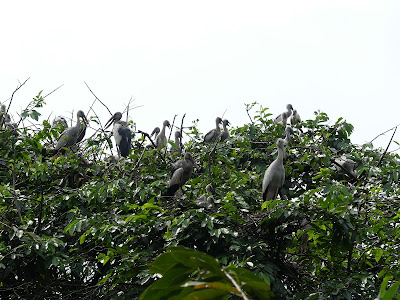The next morning we revisited the tanks and managed to see Black Bittern at the last chance.
Black Bittern
We had one last look at the fruit bats and the waterbirds while Parakeets and Barbets flew around in the branches above our heads.
Indian Flying Fox
Brown-headed Barbet
Pheasant-tailed Jacana
Cattle Egret
Pied Kingfisher
Then it was time to move on again. We were only travelling for a couple of hours and reached the Grand Udawalewe Hotel for midday and had a brief break before setting off to the last national park of our tour.
Blue-tailed Bee-eater
Elephants again
Painted Storks
Next morning, we began our journey, culminating in a drive up a slow road punctuated by many hairpin bends, to Sinharaja. We made a few stops to watch birds, including close views of Black Eagle, along the way.

Here we were to stay in the Blue Magpie Lodge, a very basic lodge that in our case, provided a room not only with a resident Gecko, but also a creature that uttered eery screaching sounds while walking the walls. Again our arrival occurred close to midday and it was arranged that we would walk into the rainforest starting at 2pm. We were soon to learn that it is regular for rain to fall from 11am onwards - and that day was no exception. We were to walk 1.5km, up hill, before reaching the entrance gate. The rain was heavy and we put on rain jackets, but the humidity was such that we were still soaked when we got there. In the rain it was difficult to see birds. There were few clearings and we managed to connect with just one small flock and had closer views of the endemic Myna. We did manage to see a pair of Sri Lanka Frogmouth.
Sri Lanka Frogmouth
Green Garden Lizzard
We walked back in failing light and were grateful to be offered a lift down, in a jeep that was collecting two other guests at the lodge. Even though the track was tortuous and the vehicle appeared to be full of leeches, it was still better than walking.
Next morning we couldn't go straight into the reserve as there was a reliable site outside that we needed to visit. Here our guide was unable to locate the Serendib Scops Owl but we had no trouble seeing Sri Lanka Ashy-headed Laughing Thrush, Sri Lanka Red-faced Malkoha, Sri Lanka Junglefowl, Sri Lanka Spurfowl and Slaty-legged Crake although the light levels were low.
Sri Lanka Spurfowl
Slaty-legged Crake
Sri Lanka Junglefowl
Then, it was back in the jeep to head up to the reserve proper. The clouds were already drifting down amongst the trees and rain threatened.
Ashy-headed Laughing Thrush
Sri Lanka Tree Nymph
There were a number of interesting plants, including the below undentified orchid and a species of pitcher plant.
The rain held off until after midday, but once it started, there was a complete deluge. This is called a rainforest for a reason. We shared an umbrella and walked down to the starting point rather than risk the jeep journey on a track that would be awash. Of course, leeches are also more active in wet conditions.
The path becomes a river.
Back at Blue Magpie Lodge, once the rain eased off, we watched birds in the garden while pondering how we might pick up on a few endemics that we had still failed to connect with.
Legge's Flowerpecker - female
Yellow-fronted Barbet
Sri Lanka Hanging Parrot
Pale-billed Flowerpecker
Lakshma agreed to take us back to the park office first thing, where the Magpies are seen regularly in the early morning. We also hoped to see White-faced Starling.
Dusky Palm Squirrel
Yellow-browed Bulbul
We left for breakfast knowing that there was no chance of seeing these birds now. Sri Lanka Blue Magpie was particularly gaulling since in addition to staying at a lodge named for this bird, its image also appeared on the cover of the guide book that has accompanied us on our travels.
After a breakfast of oat cakes, pancakes and marmalade we packed our things at set off for Columbo via the Talangama Wetland. Here we found that there was nothing new for us to see - it would have been a good place to start, but made a slightly lack lustre ending to our tour.
Grey-headed Swamphen
Common Tiger and Blue Tiger
Open-bill Storks
Pheasant-tailed Jucana, male and female
We carried on to the Mount Lavinia Hotel expecting that there would be no new species for our last full day in Sri Lanka. We did see some terns just off the beach and two more species, Roseate and Little, was added.
House Crows congregated in the palms between the hotel and the beach and these and the terns were the last birds that we had chance to watch.
House Crows
Next day there was nothing on the itinery but to brave the Colombo traffic and be sure to make the airport on time.
View towards Colombo across the crow proofed balcony.



































































